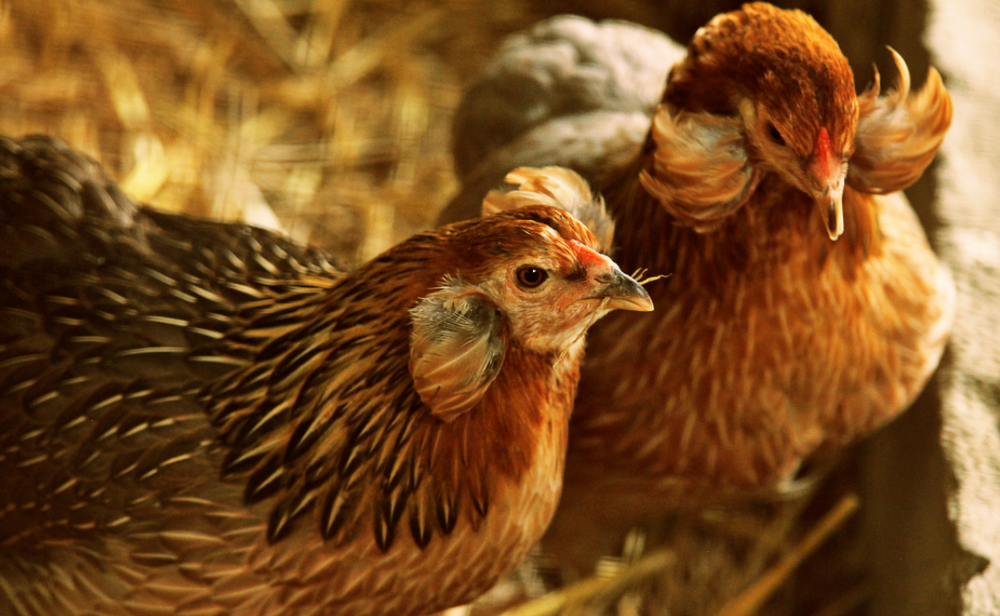The Araucana is a breed of domestic chicken from Chile. Its name derives from the Araucanía region of Chile where it is believed to have originated. It lays blue-shelled eggs, one of the very few breeds that do so.
Breed standards for the Araucana vary from country to country. It may have unusual tufts of feathers on the ears, and maybe rumpless, without a tail and tailbone; in the United States, it may, for this reason, be known as the South American Rumpless. Both ear tufts and rumplessness are caused by lethal genes, so not all birds display these traits. The Ameraucana breed and “easter egger” hybrids of the United States, which also lay blue or green eggs, both derive from the Araucana.
The trait of laying blue or greenish eggs persisted and now breeders are attempting to standardize the physical makeup of the population and gain recognition as a breed.
Some of the Araucanas were rumpless and possessed some interesting ear tufts. Probably at some time in the future, these fowls will be developed into an interesting breed with both economic and ornamental attributes.

Characteristics of Araucana Chicken
There are both full-sized and bantam Araucanas. They may be either normally tailed or rumpless. The Araucana has a pea comb and lays approximately 250 blue or green eggs per year.
In Australia, only the tailed Araucana is recognized in the Australian Poultry Standards; both tailed and rumpless may be exhibited.
The British standard accepts both tailed and rumpless; they may be treated as separate breeds. The British type of Araucana has a beard and muffs which conceal the earlobes.
In North America, Araucanas have long ear-tufts and are rumpless. As both ear tufts and rumplessness are caused by autosomal dominant lethal alleles, not all birds can display these traits.
A total of twenty plumage varieties are listed for the Araucana by the Entente Européenne d’Aviculture et de Cuniculture. Of these, five are recognized by the American Poultry Association for large fowl: black, black-breasted red, silver duckwing, golden duckwing, and white; for bantams, the buff is added to these.
The Australian Poultry Standard recognizes black, cuckoo, lavender, splash, white, and any color which is standard in Old English Game. The Poultry Club of Great Britain recognizes twelve colors: black, black-red, blue, blue-red, creole, cuckoo, golden duckwing, lavender, pile, silver duckwing, spangled, and white.
Frequently Asked Questions Related to Araucana Chicken
Are Araucana chickens good layers?
Since Araucanas are on the smaller side, they are not ideal as meat birds, but what they lack in meat makes up for beautiful blue eggs. Even though hens are smaller, their eggs are medium-sized and perfect for your Easter basket, and hey, you don’t even have to color them.
What is the difference between Araucana and Ameraucana chickens?
Ameraucanas have beards AND muffs, and Araucanas can have ear tufts. While Ameraucanas are more common in the United States than Araucanas, they are available primarily through reputable breeders. If you are in the market for Ameraucanas and see an advertisement for “Americanas,” be forewarned: there is no such breed.
How many eggs do Araucana chickens lay?
On average Araucana chickens lay between 150 to 180 strikingly vibrant eggs per year. Some people believe that blue Araucana eggs actually contain less cholesterol however this has been debunked by scientists for many years.
Are Araucana chickens rare?
Araucanas are an extremely rare breed of chicken with tufts of feathers emerging from either side of their faces. The tufts are unique to the breed and are often referred to as the ‘beard’. One of the most exquisite traits of the Araucana is their eggs which are a pale bluish colour.
Are Araucana chickens noisy?
Araucana chickens aren’t louder than other breeds, but they do tend to be more talkative than a lot of other breeds.
Do Araucana eggs taste different?
The novelty of the eggs is limited primarily to their color: the taste doesn’t differ noticeably from the regular free-range eggs more commonly found at the market. Still, they’re undeniably pretty and, more importantly, are absolutely delicious.
What color eggs do Araucana chickens lay?
Araucanas are rumpless (without a tail head), are often tufted (tufts of feathers hang by fine, elastic skin threads on each side of the head) and lay blue eggs.
How much do Araucana chickens cost?
For a true, purebred Ameraucana, you are looking at about $20-$25 for a hen and slightly less for a rooster, roughly $18. These prices also depend on the breeder, the color and lineage of the chicken, and availability.
At what age do Araucanas start laying?
Araucanas start laying between 20 and 24 weeks of age. Their egg-laying expectation is relatively fast, considering they are a heritage breed. Their fast maturity means you don’t have to wait too long to see and get the famous blue egg in your basket! If you’re keeping Araucanas just for eggs, make sure only to get hens.
Do Araucana Roosters have tails?
Look at an Araucana and the first thing you notice is that birds in this breed are missing their tail feathers, a characteristic that is referred to as “rumpless.” The other surprise is that while the breed has no tail feathers, it does have small ones growing from a flap of skin near the chicken’s ears.
What color are Araucana chickens?
Araucanas are available in Black, Black-Red, Blue, Blue-Red, Crele, Cuckoo, Golden Duckwing, Lavender, Pile, Silver Duckwing, Spangled, and White (Standardised). Useful to know: Called Ameraucana in America. When crossed with any other breed, the offspring will lay a green/blue egg. Photo: Black Bantam Araucana owned by Ken Nash.
Which chicken breed has no tail?
There are many breeds of chickens that have no tails but the most popular is Araucana. Pedigree Araucana chickens neither have tail feathers nor caudal vertebrae. They also have no uropygial gland. As a result, it is very difficult to tell roosters and hens apart at first glance.
See Also: